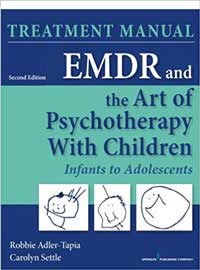 420 pages (322 testable pages)
420 pages (322 testable pages)8 CE credits
Course Enrollment
$200.00
Add to Cart
All exams are taken online. The exam for this course will be available in "My Courses" immediately upon enrollment. Note the book is not included.
The book is available for purchase from Amazon.
As an Amazon Associate we receive a rebate from qualifying purchases.
EMDR AND THE ART OF PSYCHOTHERAPY WITH CHILDREN
Infants to Adolescents, 2nd Edition
Robbie Adler-Tapia, Ph.D, and Carolyn Settle, LCSWSpringer Publications, 2016
DESCRIPTION
Expanded to include EMDR therapy with infants to adolescents, this updated and revised manual--the only resource of its kind--accompanies the new second edition of the widely praised foundational text, EMDR and the Art of Psychotherapy With Children. The manual distills simple and practical ways to employ EMDR therapy scripted protocols and forms to effectively utilize the entire EMDR therapy eight-phased treatment with infants, toddlers, young children, preteens, and teens from a developmental perspective. It is organized in accordance with the book and provides step-by-step directions, session protocols, scripts, and forms for each phase of the protocol, along with instructions for integrating techniques and tools from play, art, sand tray, and other helpful therapies.
The manual mirrors revisions to the text including changes to the phases of EMDR therapy and target identification and the integration of developmental theory into EMDR therapy for use with infants to adolescents. Additional revisions include coverage of new specialties and updated protocols, the presentation of breakthrough narrative concepts, new resources and scripts, guidance for the use of EMDR therapy with specialty populations, and new case studies of infants, toddlers, preteens, and adolescents. The manual will greatly assist therapists in their goal of providing best practices for children in need of expert psychotherapy.
New to the Second Edition:
• Includes updated scripted protocols and forms
• Integrates developmental theory into the eight phases of EMDR therapy for use with infants, toddlers, preschoolers, children, preteens, and adolescents
• Highlights that describe additional specialties and protocols
Includes breakthrough narrative therapeutic concepts to use with young children
• Provides new resourcing and other scripts for teaching children affect management
• Integrates play therapy and other expressive techniques for use with any age client
• Guides therapists in using EMDR therapy with specialty populations
• Presents case studies of EMDR therapy use with infants, toddlers, preteens, and adolescents
• Revises phases of EMDR therapy for history taking, case conceptualization, and treatment planning
• Offers updates for cognitive interweaves and other tools for blocked processing and client resistance to EMDR therapy
Key Features:
• Provides the only manual available to help therapists to use EMDR therapy with children ranging from infancy to adolescence
• Organized in accordance with the accompanying text
• Includes step-by-step directions, session protocols, scripts, and forms for each phase of the protocol
• Provides instructions for integrating techniques and tools from play, art, sand tray, and other helpful therapies
• Facilitates the skills--from basic to advanced--needed for best practices
The reader will be able to:
• Compare Eye Movement Desensitization and Reprocessing (EMDR) techniques with other therapeutic techniques used with children
• Apply techniques in history-taking, case conceptualization and treatment planning
• Explain the mechanics involved in EMDR
• Recognize the stop signal
• Use metaphor when dealing with children
• Create safe/calm place
• Discuss container exercises
• Identify and assess the levels and components of a client's memory
• Explain how desensitization works and devise a plan to focus on memory
• Determine when installation would be optimum
• Explain the technique of body scan
• Analyze your closure techniques to ensure the patient's well-being between sessions is optimized
• Examine the pros and cons of EMDR use for Autism Spectrum Disorder
AUTHOR
Robbie Adler-Tapia, Ph.D, is a licensed psychologist who has worked with children and families for over 30 years. She presents internationally on treating trauma in children, including using EMDR Therapy for attachment and dissociation. Carolyn Settle, MSW, LCSW, in private practice in Arizona for over 38 years, is an EMDRIA-approved consultant, and EMDR Institute Facilitator, and an EMDR Trauma Recovery HAP trainer.
ISHK CE at Home
1702-L Meridian Ave., #266
San Jose, CA 95125-5586
This website uses cookies to ensure you get the best experience on our website. Learn more
